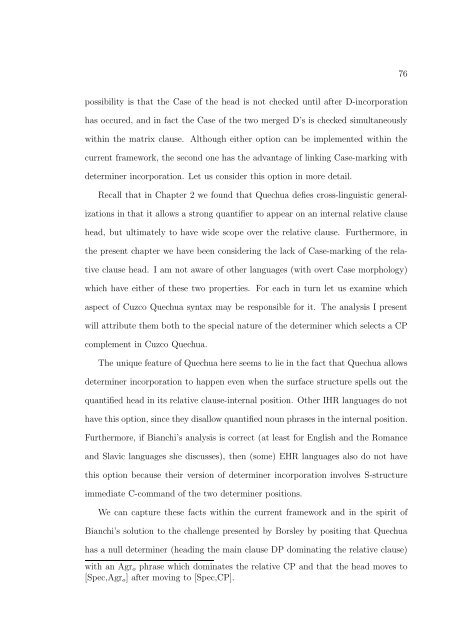the syntax and semantics of relativization and quantification
the syntax and semantics of relativization and quantification
the syntax and semantics of relativization and quantification
Create successful ePaper yourself
Turn your PDF publications into a flip-book with our unique Google optimized e-Paper software.
76<br />
possibility is that <strong>the</strong> Case <strong>of</strong> <strong>the</strong> head is not checked until after D-incorporation<br />
has occured, <strong>and</strong> in fact <strong>the</strong> Case <strong>of</strong> <strong>the</strong> two merged D’s is checked simultaneously<br />
within <strong>the</strong> matrix clause. Although ei<strong>the</strong>r option can be implemented within <strong>the</strong><br />
current framework, <strong>the</strong> second one has <strong>the</strong> advantage <strong>of</strong> linking Case-marking with<br />
determiner incorporation. Let us consider this option in more detail.<br />
Recall that in Chapter 2 we found that Quechua defies cross-linguistic generalizations<br />
in that it allows a strong quantifier to appear on an internal relative clause<br />
head, but ultimately to have wide scope over <strong>the</strong> relative clause. Fur<strong>the</strong>rmore, in<br />
<strong>the</strong> present chapter we have been considering <strong>the</strong> lack <strong>of</strong> Case-marking <strong>of</strong> <strong>the</strong> relative<br />
clause head. I am not aware <strong>of</strong> o<strong>the</strong>r languages (with overt Case morphology)<br />
which have ei<strong>the</strong>r <strong>of</strong> <strong>the</strong>se two properties. For each in turn let us examine which<br />
aspect <strong>of</strong> Cuzco Quechua <strong>syntax</strong> may be responsible for it. The analysis I present<br />
will attribute <strong>the</strong>m both to <strong>the</strong> special nature <strong>of</strong> <strong>the</strong> determiner which selects a CP<br />
complement in Cuzco Quechua.<br />
The unique feature <strong>of</strong> Quechua here seems to lie in <strong>the</strong> fact that Quechua allows<br />
determiner incorporation to happen even when <strong>the</strong> surface structure spells out <strong>the</strong><br />
quantified head in its relative clause-internal position. O<strong>the</strong>r IHR languages do not<br />
have this option, since <strong>the</strong>y disallow quantified noun phrases in <strong>the</strong> internal position.<br />
Fur<strong>the</strong>rmore, if Bianchi’s analysis is correct (at least for English <strong>and</strong> <strong>the</strong> Romance<br />
<strong>and</strong> Slavic languages she discusses), <strong>the</strong>n (some) EHR languages also do not have<br />
this option because <strong>the</strong>ir version <strong>of</strong> determiner incorporation involves S-structure<br />
immediate C-comm<strong>and</strong> <strong>of</strong> <strong>the</strong> two determiner positions.<br />
We can capture <strong>the</strong>se facts within <strong>the</strong> current framework <strong>and</strong> in <strong>the</strong> spirit <strong>of</strong><br />
Bianchi’s solution to <strong>the</strong> challenge presented by Borsley by positing that Quechua<br />
has a null determiner (heading <strong>the</strong> main clause DP dominating <strong>the</strong> relative clause)<br />
with an Agr o phrase which dominates <strong>the</strong> relative CP <strong>and</strong> that <strong>the</strong> head moves to<br />
[Spec,Agr o ] after moving to [Spec,CP].
















